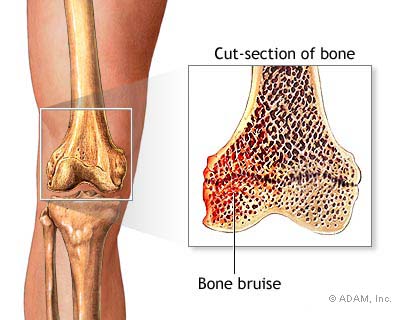Are you suffering from bruised bones? There are many treatment choices you can go for. Bone bruises range from being excruciating to uncomfortable. There are many reasons for bone bruises. Learn about bone bruises, the causes and treatment in this article.
What is a bone bruise?
Bone bruises are also referred to as bone contusions or at times bone swelling. They represent an injury type that bears similarity to tissue bruises and fractures. These bruises could be as a result of possible injury or blunt trauma to the tissues that support the bones. These days, bone bruises can be easily detected because of the availability of MRI machines. If you suspect you might have a bone bruise, you should have an MRI done to confirm or discount your suspicions.
Causes of bone bruise
 1. Spots injuries
1. Spots injuries
Sports bruises occur after the body comes into contact with hard surfaces. It could be caused by falling, or bumping into a person or equipment. Players are advised to wear protective gear like helmets and shin guards to reduce the impact of contact on the bones.
2. Trauma, falls and car accidents
The impact from car accidents is forceful enough to cause bruises on the bones. Falling and slipping can also cause bone bruises. The height of the fall can also increase the injury risks.
3. Twisting
Joint sprains and other twisting accidents can cause bruised bones. The common areas are ankles and knees.
Types of bone bruises
There are three types of bruises; subcutaneous bruises, intramuscular bruises and periosteal bone bruises. The third type is also referred to as a periosteal bruise. It is caused by the injury to the outer layer blood vessels. This is also the most painful bone bruise of the three types.
Symptoms of bone bruise
Bone bruises are usually a result of trauma on the bone from accidents. This can cause bleeding under the bone's covering. The symptoms of a bone bruise can vary based on the seriousness of the injury. It is possible to confuse these symptoms with those of other injuries like ligament, muscle bruises, as well as tendon damage.
1. Swelling
This is the leading symptom of a bone bruise. There are other injuries that can cause swelling and thus this is not always an indication of a bone bruise. In the case of bruising to tissues, the bruise will be visible on the skin. An x-ray will determine whether the swelling is a result of a bone bruise. To stop swelling, elevate the injured part and apply ice. Anti-inflammatory drugs can be taken.
2. Pain
Pain after an accident of injury is normal. However, pain intensity after a day of two is a sign of bone bruises. Over the counter pain killers like acetaminophen and ibuprofen can be used to ease the pain.
3. Stiffness
This happens when the injured bone forms a part of a joint or is close to a joint. Elbows and knees are common spots for stiffness after injury. Stiffness is also an indication of other injuries. Slow motion exercise and rest can help in the healing process.
When to see a doctor
One is advised to seek medical help for any symptoms of bone bruises. X-rays can determine the presence of fractures and whether further tests are required. Bone bruises can take time to heal; up to a few months. This is enough time for the swelling and pain to subside completely.
Bone bruise treatments
People with bone bruises should keep off aspirin and should take ibuprofen in moderate doses. Aspirin inhibits the formation of blood clots since the blood becomes thinner. This causes bleeding to worsen after injury.
1. Rest
Rest promotes healing and thus preventing further complications. Moving the injured part often can cause pain aggravation. Rest speeds up healing.
2. Painkillers
These reduce the severity of the pain in the injured area. Take NSAIDS (ibuprofen) manufactured by Motrin or Advil to relieve pain and swelling.
3. Ice massage
This relives pain in the injured part. Ice can be rubbed for 10 minutes a few times each day. Do not apply ice cubes to the skin directly. Wrap the cubes in a cloth or bag before applying.
4. Braces
Braces offer additional support to the tissues of the injured area. This prevents aggravation of the injury by minimizing the pressure. These braces also reduce healing time, reduce pain and also strengthen the affected area.
5. Supplements
Supplements like bromelain can help in the healing of bone bruises. These are mainly protein digestive enzymes that are ideal for treating injuries. The bromelain supplement is extracted from the pineapple fruit and is sold over the counter in capsules. It reduces swelling and also alleviates pain.
6. No smoking
For smokers, stopping the habit can speed up healing. Chewing tobacco is also not advisable. The nicotine present in these substances compresses the blood vessels and obstructs the circulation of the blood. This cuts the nutrients reaching the injured part hence prolonging the time for healing.
7. Healthy diet
Proper nutrition plays a very important role to facilitate recovery. So eat many fruits and vegetables every day. Fruits like guava and cherries and vegetables like spinach, carrots and cabbage are excellent healing foods.
8. Micro current therapy
This therapy speeds up the bone bruise healing process. Electric currents are passed through the injured part. It relives pain and repairs damaged tissues. This therapy also reduces the swelling and also relives chronic pain.
